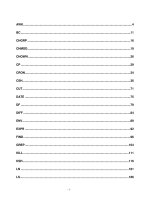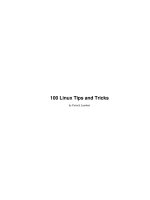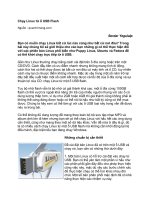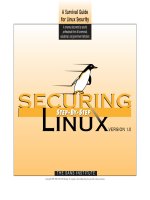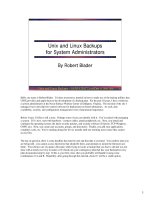Tài liệu Unix Linux Reference ppt
Bạn đang xem bản rút gọn của tài liệu. Xem và tải ngay bản đầy đủ của tài liệu tại đây (629.1 KB, 374 trang )
- 1 -
AWK....................................................................................................................................4
BC.....................................................................................................................................11
CHGRP .............................................................................................................................16
CHMOD.............................................................................................................................19
CHOWN ............................................................................................................................26
CP .....................................................................................................................................29
CRON................................................................................................................................34
CSH...................................................................................................................................36
CUT...................................................................................................................................71
DATE ................................................................................................................................75
DF .....................................................................................................................................79
DIFF ..................................................................................................................................84
ENV...................................................................................................................................89
EXPR ................................................................................................................................92
FIND..................................................................................................................................96
GREP..............................................................................................................................104
KILL ................................................................................................................................111
KSH.................................................................................................................................116
LN ...................................................................................................................................181
LS....................................................................................................................................186
- 2 -
MAKE..............................................................................................................................194
MAN................................................................................................................................234
MORE .............................................................................................................................241
MV...................................................................................................................................251
NROFF............................................................................................................................254
OD...................................................................................................................................257
PRINTF ...........................................................................................................................265
PS ...................................................................................................................................271
REGEXP .........................................................................................................................283
RM...................................................................................................................................292
SCRIPT...........................................................................................................................297
SED.................................................................................................................................298
SHUTDOWN...................................................................................................................309
SLEEP ............................................................................................................................312
SORT ..............................................................................................................................314
SPELL.............................................................................................................................324
SUM ................................................................................................................................328
TAR.................................................................................................................................330
TR ...................................................................................................................................342
TROFF ............................................................................................................................349
- 3 -
UNIQ ...............................................................................................................................352
VI.....................................................................................................................................355
WC..................................................................................................................................365
WHICH............................................................................................................................367
WHO ...............................................................................................................................370
- 4 -
awk
awk - pattern scanning and processing language
SYNOPSIS
/usr/bin/awk [ -f progfile ] [ -Fc ] [ 'prog' ]
[ parameters ] [ filename...]
/usr/xpg4/bin/awk [ -F ERE][-vassignment ... ]
'program' | -f progfile ... [ argument ... ]
DESCRIPTION
The /usr/xpg4/bin/awk utility is described on the nawk(1)
manual page.
The /usr/bin/awk utility scans each input filename for lines
that match any of a set of patterns specified in prog. The
prog string must be enclosed in single quotes (') to protect
it from the shell. For each pattern in prog there may be an
associated action performed when a line of a filename
matches the pattern. The set of pattern-action statements
may appear literally as prog or in a file specified with the
-f progfile option. Input files are read in order; if there
are no files, the standard input is read. The file name '-'
means the standard input.
OPTIONS
-f progfile awk uses the set of patterns it reads from
progfile.
-Fc Use the character c as the field separator
(FS) character. See the discussion of FS
below.
USAGE
Input Lines
Each input line is matched against the pattern portion of
every pattern-action statement; the associated action is
performed for each matched pattern. Any filename of the
form var=value is treated as an assignment, not a filename,
and is executed at the time it would have been opened if it
were a filename. Variables assigned in this manner are not
available inside a BEGIN rule, and are assigned after previ-
- 5 -
ously specified files have been read.
An input line is normally made up of fields separated by
white spaces. (This default can be changed by using the FS
built-in variable or the -Fc option.) The default is to
ignore leading blanks and to separate fields by blanks
and/or tab characters. However, if FS is assigned a value
that does not include any of the white spaces, then leading
blanks are not ignored. The fields are denoted $1, $2, ...;
$0 refers to the entire line.
Pattern-action Statements
A pattern-action statement has the form:
pattern { action }
Either pattern or action may be omitted. If there is no
action, the matching line is printed. If there is no pat-
tern, the action is performed on every input line.
Pattern-action statements are separated by newlines or semi-
colons.
Patterns are arbitrary Boolean combinations ( !, ||, &&, and
parentheses) of relational expressions and regular expres-
sions. A relational expression is one of the following:
expression relop expression
expression matchop regular_expression
where a relop is any of the six relational operators in C,
and a matchop is either ~ (contains) or !~ (does not con-
tain). An expression is an arithmetic expression, a rela-
tional expression, the special expression
var in array
or a Boolean combination of these.
Regular expressions are as in egrep(1). In patterns they
must be surrounded by slashes. Isolated regular expressions
in a pattern apply to the entire line. Regular expressions
may also occur in relational expressions. A pattern may
consist of two patterns separated by a comma; in this case,
the action is performed for all lines between the occurrence
of the first pattern to the occurrence of the second pat-
tern.
The special patterns BEGIN and END may be used to capture
- 6 -
control before the first input line has been read and after
the last input line has been read respectively. These key-
words do not combine with any other patterns.
Built-in Variables
Built-in variables include:
FILENAME name of the current input file
FS input field separator regular expression
(default blank and tab)
NF number of fields in the current record
NR ordinal number of the current record
OFMT output format for numbers (default %.6g)
OFS output field separator (default blank)
ORS output record separator (default new-
line)
RS input record separator (default new-
line)
An action is a sequence of statements. A statement may be
one of the following:
if ( expression ) statement [ else statement ]
while ( expression ) statement
do statement while ( expression )
for ( expression ; expression ; expression ) statement
for ( var in array ) statement
break
continue
{ [ statement ] ... }
expression # commonly variable = expression
print [ expression-list ] [ >expression ]
printf format [ , expression-list ] [ >expression ]
next # skip remaining patterns on this input line
exit [expr] # skip the rest of the input; exit status
is expr
Statements are terminated by semicolons, newlines, or right
braces. An empty expression-list stands for the whole input
line. Expressions take on string or numeric values as
appropriate, and are built using the operators +, -, *, /,
- 7 -
%, ^ and concatenation (indicated by a blank). The opera-
tors ++, --, +=, -=, *=, /=, %=, ^=, >, >=, <, <=, ==, !=,
and ?: are also available in expressions. Variables may be
scalars, array elements (denoted x[i]), or fields. Vari-
ables are initialized to the null string or zero. Array
subscripts may be any string, not necessarily numeric; this
allows for a form of associative memory. String constants
are quoted (""), with the usual C escapes recognized within.
The print statement prints its arguments on the standard
output, or on a file if >expression is present, or on a pipe
if '|cmd' is present. The output resulted from the print
statement is terminated by the output record separator with
each argument separated by the current output field separa-
tor. The printf statement formats its expression list
according to the format (see printf(3S)).
Built-in Functions
The arithmetic functions are as follows:
cos(x) Return cosine of x, where x is in
radians.
sin(x) Return sine of x, where x is in radians.
exp(x) Return the exponential function of x.
log(x) Return the natural logarithm of x.
sqrt(x) Return the square root of x.
int(x) Truncate its argument to an integer. It
will be truncated toward 0 whenx>0.
The string functions are as follows:
index(s, t) Return the position in string s where
string t first occurs, or 0 if it does
not occur at all.
int(s) truncates s to an integer value. If s
is not specified, $0 is used.
length(s) Return the length of its argument taken
as a string, or of the whole line if
there is no argument.
- 8 -
match(s, re) Return the position in string s where
the regular expression re occurs, or 0
if it does not occur at all.
split(s, a, fs)
Split the string s into array elements
a[1], a[2], a[n], and returns n. The
separation is done with the regular
expression fs or with the field separa-
tor FS if fs is not given.
sprintf(fmt, expr, expr,...)
Format the expressions according to the
printf(3S) format given by fmt and
returns the resulting string.
substr(s, m, n)
returns the n-character substring of s
that begins at position m.
The input/output function is as follows:
getline Set $0 to the next input record from the
current input file. getline returns 1
for successful input, 0 for end of file,
and -1 for an error.
Large File Behavior
See largefile(5) for the description of the behavior of awk
when encountering files greater than or equal to 2 Gbyte
(2**31 bytes).
EXAMPLES
Print lines longer than 72 characters:
length > 72
Print first two fields in opposite order:
{ print $2, $1 }
Same, with input fields separated by comma and/or blanks and
tabs:
BEGIN { FS = ",[ \t]*|[ \t]+" }
{ print $2, $1 }
- 9 -
Add up first column, print sum and average:
{s+=$1}
END { print "sum is", s, " average is", s/NR }
Print fields in reverse order:
{for(i=NF;i>0;--i) print $i }
Print all lines between start/stop pairs:
/start/, /stop/
Print all lines whose first field is different from previous
one:
$1 != prev { print; prev = $1 }
Print a file, filling in page numbers starting at 5:
/Page/ { $2 = n++; }
{ print }
Assuming this program is in a file named prog, the following
command line prints the file input numbering its pages
starting at 5: awk -f prog n=5 input.
ENVIRONMENT
See environ(5) for descriptions of the following environment
variables that affect the execution of awk: LC_CTYPE and
LC_MESSAGES.
ATTRIBUTES
See attributes(5) for descriptions of the following attri-
butes:
/usr/bin/awk
__________________________________
| ATTRIBUTE TYPE| ATTRIBUTE VALUE|
|_______________|_________________|
| Availability | SUNWesu |
| CSI | Enabled |
|_______________|_________________|
/usr/xpg4/bin/awk
__________________________________
| ATTRIBUTE TYPE| ATTRIBUTE VALUE|
- 10 -
|_______________|_________________|
| Availability | SUNWxcu4 |
| CSI | Enabled |
|_______________|_________________|
SEE ALSO
egrep(1), grep(1), nawk(1), sed(1), printf(3S), attri-
butes(5), environ(5), largefile(5), xpg4(5)
NOTES
Input white space is not preserved on output if fields are
involved.
There are no explicit conversions between numbers and
strings. To force an expression to be treated as a number
add 0 to it; to force it to be treated as a string concaten-
ate the null string ("") to it.
- 11 -
bc
bc - arbitrary precision arithmetic language
SYNOPSIS
bc[-c][-l][file...]
DESCRIPTION
The bc utility implements an arbitrary precision calculator.
It takes input from any files given, then reads from the
standard input. If the standard input and standard output
to bc are attached to a terminal, the invocation of bc is
interactive , causing behavioural constraints described in
the following sections. bc processes a language that resem-
bles C and is a preprocessor for the desk calculator program
dc, which it invokes automatically unless the -c option is
specified. In this case the dc input is sent to the stan-
dard output instead.
USAGE
The syntax for bc programs is as follows:
L means a letter a-z,
E means an expression: a (mathematical or logical)
value, an operand that takes a value, or a combina-
tion of operands and operators that evaluates to a
value,
S means a statement.
Comments
Enclosed in /* and */.
Names (Operands)
Simple variables: L.
Array elements: L [ E ] (up to BC_DIM_MAX dimen-
sions).
The words ibase, obase (limited to BC_BASE_MAX), and
scale (limited to BC_SCALE_MAX).
Other Operands
Arbitrarily long numbers with optional sign and
decimal point.
- 12 -
Strings of fewer than BC_STRING_MAX characters,
between double quotes (").
(E)
sqrt(E) Square root
length(E) Number of significant
decimal digits.
scale(E) Number of digits right
of decimal point.
L(E,...,E)
Operators
+-*/%^ (%isremainder; ^ is
power)
++ -- (prefix and postfix;
apply to names)
== <= >= != < >
==+=-=*=/=%=^
Statements
E
{ S ;... ; S }
if(E)S
while(E)S
for(E;E;E)S
null statement
break
quit
.string
Function Definitions
defineL(L,...,L){
auto L ,..., L
S ;... S
return(E)
}
Functions in -l Math Library
s(x) sine
c(x) cosine
e(x) exponential
- 13 -
l(x) log
a(x) arctangent
j(n,x) Bessel function
All function arguments are passed by value.
The value of a statement that is an expression is printed
unless the main operator is an assignment. Either semi-
colons or new-lines may separate statements. Assignment to
scale influences the number of digits to be retained on
arithmetic operations in the manner of dc. Assignments to
ibase or obase set the input and output number radix respec-
tively.
The same letter may be used as an array, a function, and a
simple variable simultaneously. All variables are global to
the program. auto variables are stacked during function
calls. When using arrays as function arguments or defining
them as automatic variables, empty square brackets must fol-
low the array name.
OPTIONS
-c Compile only. The output is dc commands that are
sent to the standard output.
-l Define the math functions and initialize scale to
20, instead of the default zero.
OPERANDS
The following operands are supported:
file A pathname of a text file containing bc program
statements. After all cases of file have been read,
bc will read the standard input.
EXAMPLES
In the shell, the following assigns an approximation of the
first ten digits of -n to the variable x :
x=$(printf "%s\n" 'scale = 10; 104348/33215' | bc)
Defines a function to compute an approximate value of the
exponential function:
scale = 20
define e(x){
auto a, b, c, i, s
- 14 -
a=1
b=1
s=1
for(i=1; 1==1; i++){
a = a*x
b = b*i
c = a/b
if(c == 0) return(s)
s = s+c
}
}
Prints approximate values of the exponential function of the
first ten integers:
for(i=1; i<=10; i++) e(i)
or
for (i = 1; i <= 10; ++i) {
e(i) }
ENVIRONMENT
See environ(5) for descriptions of the following environment
variables that affect the execution of bc: LC_CTYPE,
LC_MESSAGES, and NLSPATH.
EXIT STATUS
The following exit values are returned:
0 All input files were processed successfully.
unspecified An error occurred.
FILES
/usr/lib/lib.b mathematical library
/usr/include/limits.h to define BC_ parameters
ATTRIBUTES
See attributes(5) for descriptions of the following attri-
butes:
__________________________________
| ATTRIBUTE TYPE| ATTRIBUTE VALUE|
|_______________|_________________|
| Availability | SUNWesu |
|_______________|_________________|
- 15 -
SEE ALSO
dc(1), awk(1), attributes(5)
NOTES
The bc command does not recognize the logical operators &&
and ||.
The for statement must have all three expressions (E's).
- 16 -
chgrp
chgrp - change file group ownership
SYNOPSIS
chgrp [ -fhR ] group file
DESCRIPTION
The chgrp utility will set the group ID of the file named by
each file operand to the group ID specified by the group
operand.
For each file operand, it will perform actions equivalent to
the chown(2) function, called with the following arguments:
o The file operand will be used as the path argument.
o The user ID of the file will be used as the owner argu-
ment.
o The specified group ID will be used as the group argu-
ment.
Unless chgrp is invoked by a process with appropriate
privileges, the set-user-ID and set-group-ID bits of a regu-
lar file will be cleared upon successful completion; the
set-user-ID and set-group-ID bits of other file types may be
cleared.
The operating system has a configuration option
{_POSIX_CHOWN_RESTRICTED}, to restrict ownership changes.
When this option is in effect, the owner of the file may
change the group of the file only to a group to which the
owner belongs. Only the super-user can arbitrarily change
owner IDs, whether or not this option is in effect. To set
this configuration option, include the following line in
/etc/system:
set rstchown = 1
To disable this option, include the following line in
/etc/system:
set rstchown = 0
{_POSIX_CHOWN_RESTRICTED} is enabled by default. See sys-
tem(4) and fpathconf(2).
- 17 -
OPTIONS
-f Force. Do not report errors.
-h If the file is a symbolic link, change the group
of the symbolic link. Without this option, the
group of the file referenced by the symbolic link
is changed.
-R Recursive. chgrp descends through the directory,
and any subdirectories, setting the specified
group ID as it proceeds. When a symbolic link is
encountered, the group of the target file is
changed (unless the -h option is specified), but
no recursion takes place.
OPERANDS
The following operands are supported:
group A group name from the group database or a numeric
group ID. Either specifies a group ID to be given
to each file named by one of the file operands. If
a numeric group operand exists in the group database
as a group name, the group ID number associated with
that group name is used as the group ID.
file A path name of a file whose group ID is to be modi-
fied.
USAGE
See largefile(5) for the description of the behavior of
chgrp when encountering files greater than or equal to 2
Gbyte (2**31 bytes).
ENVIRONMENT
See environ(5) for descriptions of the following environment
variables that affect the execution of chgrp: LC_CTYPE,
LC_MESSAGES, and NLSPATH.
EXIT STATUS
The following exit values are returned:
0 The utility executed successfully and all requested
changes were made.
>0 An error occurred.
- 18 -
FILES
/etc/group group file
ATTRIBUTES
See attributes(5) for descriptions of the following attri-
butes:
______________________________________
| ATTRIBUTE TYPE| ATTRIBUTE VALUE |
|_______________|_____________________|
| Availability | SUNWcsu |
| CSI | Enabled (see NOTES)|
|_______________|_____________________|
SEE ALSO
chmod(1), chown(1), id(1M), chown(2), fpathconf(2),
group(4), passwd(4), system(4), attributes(5), environ(5),
largefile(5)
NOTES
chgrp is CSI-enabled except for the group name.
- 19 -
chmod
chmod - change the permissions mode of a file
SYNOPSIS
chmod [ -fR ] <absolute-mode> file...
chmod [ -fR ] <symbolic-mode-list> file...
DESCRIPTION
chmod changes or assigns the mode of a file. The mode of a
file specifies its permissions and other attributes. The
mode may be absolute or symbolic.
Absolute mode
An absolute mode is specified using octal numbers:
chmod nnnn file ...
where:
n a number from 0 to 7. An absolute mode is
constructed from the OR of any of the follow-
ing modes:
4000 Set user ID on execution.
20#0 Set group ID on execution if # is
7, 5, 3, or 1.
Enable mandatory locking if # is 6,
4, 2, or 0.
For directories, files are created
with BSD semantics for propagation
of the group ID. With this option,
files and subdirectories created in
the directory inherit the group ID
of the directory, rather than of
the current process. It may be
cleared only by using symbolic
mode.
1000 Turn on sticky bit. See chmod(2).
0400 Allow read by owner.
0200 Allow write by owner.
0100 Allow execute (search in directory)
by owner.
0700 Allow read, write, and execute
- 20 -
(search) by owner.
0040 Allow read by group.
0020 Allow write by group.
0010 Allow execute (search in directory)
by group.
0070 Allow read, write, and execute
(search) by group.
0004 Allow read by others.
0002 Allow write by others.
0001 Allow execute (search in directory)
by others.
0007 Allow read, write, and execute
(search) by others.
Note that the setgid bit cannot be set (or cleared) in abso-
lute mode; it must be set (or cleared) in symbolic mode
using g+s (or g-s).
Symbolic mode
A symbolic mode specification has the following format:
chmod <symbolic-mode-list> file...
where: <symbolic-mode-list> is a comma-separated list (with
no intervening whitespace) of symbolic mode expressions of
the form:
[who] operator [permissions]
Operations are performed in the order given. Multiple per-
missions letters following a single operator cause the
corresponding operations to be performed simultaneously.
who zero or more of the characters u, g, o, and a
specifying whose permissions are to be
changed or assigned:
u user's permissions
g group's permissions
o others' permissions
a all permissions (user, group, and
other)
If who is omitted, it defaults to a, but the
setting of the file mode creation mask (see
umask in sh(1) or csh(1) for more informa-
tion) is taken into account. When who is
omitted, chmod will not override the restric-
- 21 -
tions of your user mask.
operator either +, -, or =, signifying how permissions
are to be changed:
+ Add permissions.
If permissions is omitted, nothing
is added.
If who is omitted, add the file
mode bits represented by permis-
sions, except for the those with
corresponding bits in the file mode
creation mask.
If who is present, add the file
mode bits represented by the per-
missions.
- Take away permissions.
If permissions is omitted, do noth-
ing.
If who is omitted, clear the file
mode bits represented by permis-
sions, except for those with
corresponding bits in the file mode
creation mask.
If who is present, clear the file
mode bits represented by permis-
sions.
= Assign permissions absolutely.
If who is omitted, clear all file
mode bits; if who is present, clear
the file mode bits represented by
who.
If permissions is omitted, do noth-
ing else.
If who is omitted, add the file
mode bits represented by permis-
- 22 -
sions, except for the those with
corresponding bits in the file mode
creation mask.
If who is present, add the file
mode bits represented by permis-
sions.
Unlike other symbolic operations, = has an
absolute effect in that it resets all other
bits represented by who. Omitting permis-
sions is useful only with = to take away all
permissions.
permission
any compatible combination of the following
letters:
r read permission
w write permission
x execute permission
l mandatory locking
s user or group set-ID
t sticky bit
u,g,o indicate that permission is to be
taken from the current user, group
or other mode respectively.
Permissions to a file may vary depending on
your user identification number (UID) or
group identification number (GID). Permis-
sions are described in three sequences each
having three characters:
User Group Other
rwx rwx rwx
This example (user, group, and others all
have permission to read, write, and execute a
given file) demonstrates two categories for
granting permissions: the access class and
the permissions themselves.
The letter s is only meaningful with u or g,
and t only works with u.
Mandatory file and record locking (l) refers
- 23 -
to a file's ability to have its reading or
writing permissions locked while a program is
accessing that file.
In a directory which has the set-group-ID bit
set (reflected as either -----s--- or -----
l--- in the output of 'ls -ld'), files and
subdirectories are created with the group-ID
of the parent directory-not that of current
process.
It is not possible to permit group execution
and enable a file to be locked on execution
at the same time. In addition, it is not
possible to turn on the set-group-ID bit and
enable a file to be locked on execution at
the same time. The following examples,
therefore, are invalid and elicit error mes-
sages:
chmod g+x,+l file
chmod g+s,+l file
Only the owner of a file or directory (or the
super-user) may change that file's or
directory's mode. Only the super-user may
set the sticky bit on a non-directory file.
If you are not super-user, chmod will mask
the sticky-bit but will not return an error.
In order to turn on a file's set-group-ID
bit, your own group ID must correspond to the
file's and group execution must be set.
OPTIONS
The following options are supported:
-f Force. chmod will not complain if it fails to
change the mode of a file.
-R Recursively descend through directory arguments,
setting the mode for each file as described above.
When symbolic links are encountered, the mode of
the target file is changed, but no recursion takes
place.
OPERANDS
- 24 -
The following operands are supported:
mode Represents the change to be made to the file mode
bits of each file named by one of the file
operands; see DESCRIPTION.
file A path name of a file whose file mode bits are to
be modified.
USAGE
See largefile(5) for the description of the behavior of
chmod when encountering files greater than or equal to 2
Gbyte (2**31 bytes).
EXAMPLES
Deny execute permission to everyone:
example% chmod a-x file
Allow only read permission to everyone:
example% chmod 444 file
Make a file readable and writable by the group and others:
example% chmod go+rw file
example% chmod 066 file
Cause a file to be locked during access:
example% chmod +l file
Allow everyone to read, write, and execute the file and turn
on the set group-ID.
example% chmod a=rwx,g+s file
example% chmod 2777 file
ENVIRONMENT
See environ(5) for descriptions of the following environment
variables that affect the execution of chmod: LC_CTYPE,
LC_MESSAGES, and NLSPATH.
EXIT STATUS
The following exit values are returned:
- 25 -
0 Successful completion.
>0 An error occurred.
ATTRIBUTES
See attributes(5) for descriptions of the following attri-
butes:
__________________________________
| ATTRIBUTE TYPE| ATTRIBUTE VALUE|
|_______________|_________________|
| Availability | SUNWcsu |
| CSI | enabled |
|_______________|_________________|
SEE ALSO
ls(1), chmod(2), attributes(5), environ(5), largefile(5)
NOTES
Absolute changes don't work for the set-group-ID bit of a
directory. You must use g+s or g-s.
chmod permits you to produce useless modes so long as they
are not illegal (for instance, making a text file execut-
able). chmod does not check the file type to see if manda-
tory locking is meaningful.
If the filesystem is mounted with the nosuid option, setuid
execution is not allowed.


